Varietal features of the Orlinka apple tree
The Orlinka apple tree was bred in 1987 by crossing the Stark and Perviy Salyut varieties. Since 2001, the subspecies has appeared on the territory of Russia and Ukraine, and since that time it has been grown on any land plots, especially in the middle zone. The apple tree of this variety is beautiful, unpretentious and gives a stable harvest - for these qualities it is loved by gardeners.
- Characteristic
- Advantages and disadvantages
- Description of fruit
- Description of the tree
- Growing regions
- Planting varieties
- Landing dates
- Site and seedling selection
- Landing technology
- Care
- Fertilizing the soil
- Pruning branches
- Preventive work
- Ripening and fruiting
- Harvest storage
- Variety subspecies
- Gardeners reviews
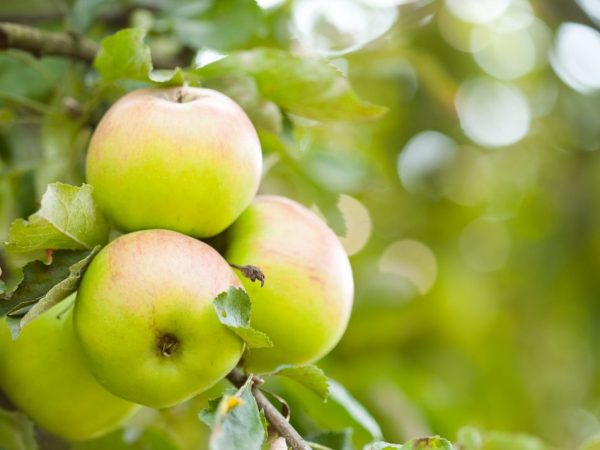
Varietal features of the Orlinka apple tree
Characteristic
The summer variety ripens by mid-August. In terms of timing, it is similar to the view of Malba. The same tasty fruits are formed on strong branches. The average shelf life of fruits is no more than a month - this disadvantage is leveled by the beneficial composition of apples.
Description of the variety:
- fast-growing;
- the first fruits are formed in the 5th year - if a suitable stock is selected;
- high yield - up to 150 centners per 1 hectare of the garden plot;
- good disease resistance;
- the tree endures the cold;
- drought resistance is average.
Orlinka is a good pollinator for other horticultural crops.
Apple trees Papirovka and Malba are planted next to the tree. Such varieties bloom in one period and enhance the quality characteristics of each other. Cross-pollination allows for more fruit to be harvested - they are medium to large in size depending on the rootstock.
Advantages and disadvantages
Orlinka is a popular culture, its advantages outweigh the disadvantages. High winter hardiness allows you to plant a tree even in the north of the country, where winter frosts alternate with sudden temperature changes. The apple tree does not freeze, and if small shoots or roots suffer, they quickly recover in the spring.
Unpretentious care is another important advantage of the variety. Standard watering and feeding used for other horticultural crops will work for this apple tree as well.
The taste of the fruit makes it look so popular. If we summarize the unpretentiousness of the culture and the high quality of apples, Orlinka is an indispensable variety in an orchard of any size. The species for sale is grown due to its good transportability. Early maturity and high yields are the qualities for which gardeners choose the variety.
The hybrid has few drawbacks. It does not have a high keeping quality - this is its main disadvantage. The fruits are not stored for long, so they are immediately used for sale or for processing. Unsuitable conditions partially, but affect the quality indicators of apples.
If the culture is not watered in the early years, it may not grow to the desired height - the number of fruits will be less.
Description of fruit
Fruits are large and medium-sized in unfavorable conditions. The weight of one apple is from 150 to 210 g. The variety is distinguished by a weak ribbing of the fruit and a slight elongation if the tree grows on a poorly lit land plot.
Description of fruits:
- apples have a smooth, shiny rind;
- it is thin but strong - it is easy to cut it;
- glossy tint appears closer to the ripening period;
- apples have a yellow-green color;
- the longer the fruits “reach” the desired state on the branches, the more yellow their rind.
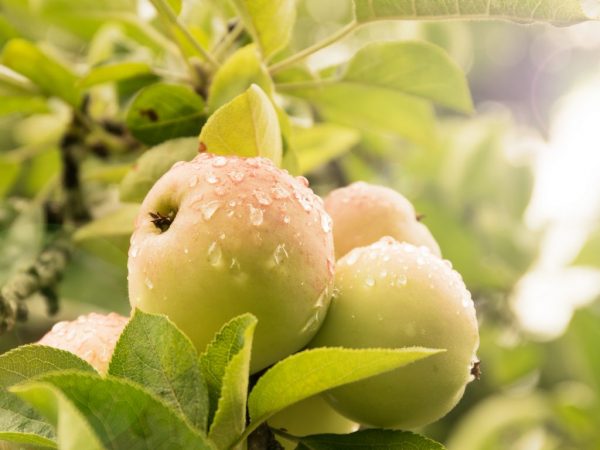
Apples are delicious and healthy.
The pulp is light in color. It is creamy and juicy. It contains coarse-grained fibers.
The taste is sweet and sour. The pulp is fragrant. The tasting score is 5 points. The pulp has a balanced useful composition: it contains ascorbic acid and other vitamins.
Description of the tree
The trees are tall with a wide dense crown. The shape of the crown is round - it is formed twice a year, because the species has a rapid growth of lateral branches.
Description of the leaves: large, rounded, dark green in color. The variety is distinguished by medium-sized flowers. Their color is light pink.
The annual growth is moderate - up to 50 cm every year. After 3-4 years, only lateral branches grow actively, and the growth of stem shoots stops.
Growing regions
The best conditions for the growth of culture have developed in central Russia. The main goal of the breeding was to create a variety that can survive frosty winters. As a result, Orlinka was planted throughout central Russia.
The variety will take root well in Orenburg and Siberia. For such regions, it is better to establish proper care - it is based on warming and sheltering the culture for the winter. Good adaptation of the apple tree is noted in Belarus and on the territory of Ukraine.
Planting varieties
Orlinka is an adaptive variety. It is planted according to the standard scheme: like the rest of the fruit trees in the garden. To make the apple tree sprout faster, the gardener conducts the following activities:
- chooses a land plot;
- fertilizes the soil - this procedure takes from 2 weeks to a month;
- chooses a seedling - the better the material, the faster its growth in new conditions;
- landing;
- establishes regular care.
Fertile soil is selected before planting. If it is clayey, it is better to add 2-3 buckets of sand. If sandy, the grower adds clay. Such activities will help balance the composition of the soil layer.
Landing dates
Apple trees take root twice a year. They carry out spring and autumn planting. The work schemes are the same, but each procedure has its own preparation.
Depending on the term, planting should be carried out in this way:
- mid-May. In spring, fruit trees recover quickly - internal processes are resumed. The exact landing period depends on the region where the land is located. The warmer the climate in spring, the earlier the procedure can be carried out. It is better to wait until the soil layer warms up to a temperature of 12-14 ° C. If it gets colder, the young tree will die. A guideline for the gardener is the buds that have not blossomed on mature fruit trees in the garden. If the buds have appeared, it is too late to plant the planting material. After 1-2 weeks, regular care is established;
- mid-October. The second type of planting is carried out after harvesting. It is necessary to free the trees from fruits, to clean up the land. If you are planning an autumn planting, the pit is prepared in advance - 2 weeks in advance. The gardener calculates the time so that at least a month remains before frost. After the procedure, the tree is insulated, covered for the winter.
The Orlinka apple variety germinates well in spring and autumn. Before winter, the seedling is mulched. This is an important condition so that the planting material does not suffer from the first frost. Hay, grass, peat are used as mulch. Only mature trees do not shelter before winter.
Site and seedling selection
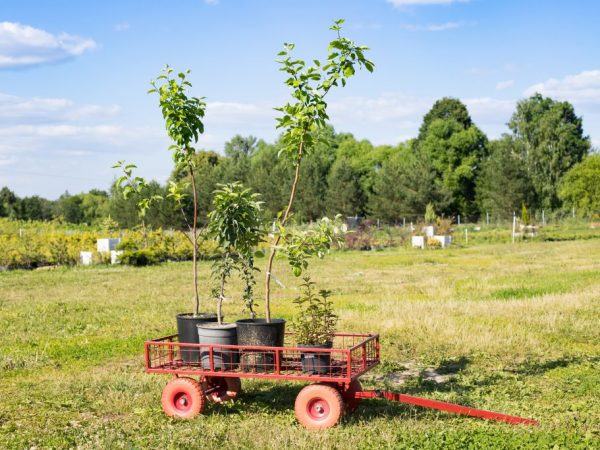
Choose healthy and strong trees for planting
A lighted area is needed for a seedling. Lowlands are not suitable for such purposes. If the site is large, there is a lot of stagnant water in them - such a liquid leads to rotting of the roots of the tree. Land plots with a groundwater height of 2.5 m are not suitable for this apple tree variety.
The seedling is chosen according to two criteria - the age of the crop and its condition.
The best option is two-year material. It grows and develops faster than an annual seedling. The appendix has a uniform dark bark. If damaged a little, the inside is green. On the root system, which is moderately elastic and strong, there should be no spots or signs of decay.
The leaves that appeared on the seedling indicate an incorrect grafting of the material.
Landing technology
The tree has a good root system. It grows quickly and requires a lot of space. To prevent the roots from suffering from high groundwater, drainage is used. Stones or rubble are laid at the bottom of the planting pit.
The main feeding for a seedling is fertilizing the planting pit.
Pre-dig a hole up to 80 cm deep and 1 m in diameter.If you plan to plant in spring, prepare the hole in the fall. An organic fertilizer with a thickness of at least 6-7 cm is placed on its bottom. After that, the hole is covered with a film so that the organic matter is better absorbed.
A week later, a hole is dug. After 7 days, planting can be carried out - on the same day, drainage is laid.
Before planting, it is worth soaking the seedling in water for 1 day. Before introducing it into the ground, the roots must be leveled so that they grow faster. Lay fresh soil on top. Its top layer is leveled. You need to tamp the ground carefully so as not to damage the roots.
Immediately after that, watering is carried out - up to 6 buckets of purified water are prepared.
Care
Orlinka does not require special care. Watering, feeding and pruning is carried out according to the standard scheme. Prevention - along with other fruit trees.
Watering depends:
- from the region and its climatic features;
- from daytime temperature in summer - its frequent drops affect the condition of the soil;
- on the level of humidity;
- on the composition of the soil.
If the soil dries out between waterings, you need to increase the amount of added moisture.
Abundant moisture ensures stable vegetation of the tree. Use warm water - rain or technical. Evening drip irrigation is carried out. If possible, the water is heated, leaving the container with it for the whole day in direct sunlight.
Watering is not carried out for the winter. It is good to combine irrigation with soil fertilization.
Fertilizing the soil
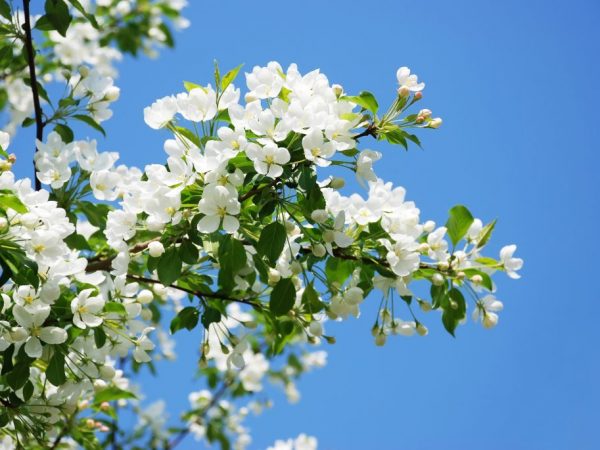
The tree must be fertilized three times per season.
Two types of feeding are carried out - foliar and root. Irrigation with a nutrient solution is used during the formation of ovaries. You cannot carry out the procedure during the day, so that burns do not form on the leaves.
Mineral fertilizers are used for irrigation: they contain a large amount of potassium, phosphorus and nitrogen. Organic matter is applied at the root during the formation of the fruit.
You need 2-3 soil fertilizers per season. In winter, top dressing is not used.
Pruning branches
Pruning is carried out without fail - spring, which is called formative, and autumn (sanitary).
These procedures are carried out in this way:
- after winter. The internal processes of the tree are activated. The gardener observes the state of the culture. There are already green leaves on the branches, but no buds yet. Garden tools are treated with a disinfectant solution. Remove old branches and crooked shoots that only interfere with the apple tree. Places of cuts are treated with garden pitch;
- before winter. Sanitary pruning is more important than a similar spring procedure. When the crop is harvested, remove old twigs, stained and diseased shoots. Places of cuts are treated with a disinfectant solution. After pruning, the tree is insulated for the winter.
A crown is formed in the spring, and prevention is carried out before winter.
Preventive work
Preparation for winter begins with pest control. Threatens the apple tree with aphids. To prevent the attack of parasites, spraying is carried out in February or March, when the ambient temperature rises. Copper sulfate diluted with water is used.
The second spraying is carried out from April to May.
Before flowering, the tree needs additional protection. The third spraying is carried out in June. Use the drug "Aktar" or "Nitrafen".The last spraying is in October. Iron vitriol is used. Insecticides are suitable to protect the tree from pests. Chemical and biological additives are only suitable for adult crops.
The tree can also be threatened by common diseases such as scab and powdery mildew. To overcome the former, use Bordeaux liquid. In the second case, fungicides are suitable.
Ripening and fruiting
The first fruiting occurs in the 5th year. If ovaries appear in the 4th year, they are removed. From the first fruiting, the yield increases every year. The flowering of the variety is beautiful. The first inflorescences can be seen in the first half of May. The flowering period is one month.
The fruits ripen by autumn. Collect them at the same time, tk. they ripen evenly. Fruiting coincides with the Melba variety. Apples do not have a good keeping quality, so there is no need to leave fruit on the branches. As soon as the fruits change color, they need to be harvested.
Harvest storage
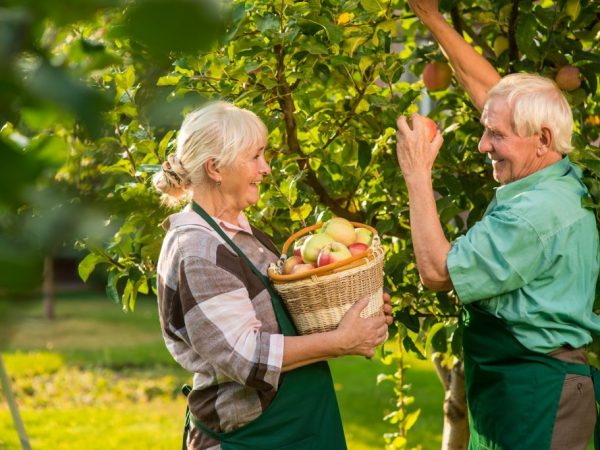
Store apples of different varieties separately from each other.
When the harvest is over, the fruits are collected in boxes. It is better to store fruits of the same type in them, without mixing with other types. Before that, the fruits are not washed, but only dried in the sun - you can wipe them with a dry napkin.
If the apple starts to rot, it is removed from the box. The average shelf life is 1-1.5 months.
Variety subspecies
The best option for the species is a low-growing stock. Under such conditions, fruiting occurs earlier. It is distinguished by its high yield. A low-growing stock is used to obtain an industrial, productive variety.
Small trees grow - it is easier to treat them from pests and diseases. The size of the fruit is large, which improves the quality characteristics of the fruit. With a short rootstock, it is easier to form a crown.
Culture takes up less space. It grows moderately, and the apple tree lives on a columnar rootstock 2-3 times longer. Low-growing rootstocks freeze more often.
On a semi-dwarf rootstock, the height of the tree is no more than 4 m. The first fruiting occurs in the 4th year. The dwarf rootstock is the easiest to care for. The average height of one tree is 3 m. The culture bears fruit in the 3rd year.
Gardeners reviews
The Orlinka variety is one of the most popular and demanded in central Russia. Experienced gardeners love the culture for its simplicity and high yield. Immediately after planting, the tree quickly adapts. Standard watering and feeding will allow the planting material to develop and bear fruit already in the 4th year.
Experienced gardeners note the culture's resistance to common diseases. The advantage of the variety is stable fruiting. Over the years, it grows, which allows you to get a tasty, healthy harvest.

